
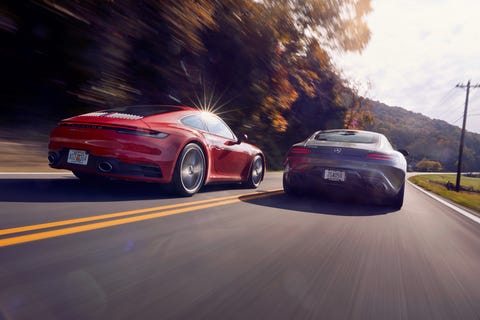
But death and devastation were too much to consider for too long, so we busied ourselves with less grave questions, such as: How, after three hours at a total standstill, have we not seen more stranded drivers peeing on the side of the road? And, more urgently, where are we going to pee? And what would possess someone to affix fluffy seat covers topped with teddy-bear heads to the front seats of their car? Also, who is smoking weed right now? We can smell it, you know.
We also spent some of our unexpected downtime considering a response to the question you're surely asking: Where the hell is the 2020 Chevrolet Corvette? The short answer is that the new Corvette is here. The less flippant answer is that there will be all manner of Corvette stories in the future, including comparison tests. There will be so many, in fact, that you will begin asking why all stories have to have a Corvette in them.
For now, we must first sort these two contenders in what might be called the everyday-supercar class. The cars we've gathered here, the new-generation Porsche 911 Carrera S and the familiar Mercedes-AMG GT, straddle the divide between day-to-day commuting comfort and back-road friskiness. Both carry prices that blast through the $100,000 mark by a considerable margin, making them a little too dear for head-to-head competition with the five-figure Corvette.
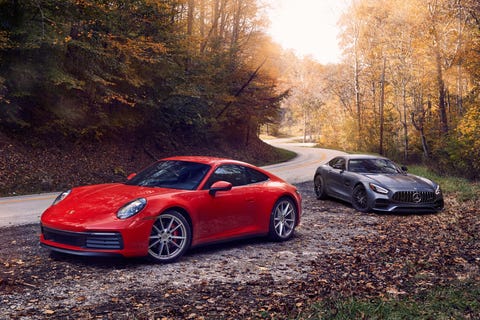
Even at an as-tested price of $122,540, the 992-generation Carrera S is the less expensive of the two. And our test car is a relative stripper (not a stripper relative). Porsche has a panoply of options to boost that price, if you'd like. But no matter how much you spend on a Carrera S, you still get the same rear-mounted 443-hp twin-turbocharged 3.0-liter flat-six of our test car. A seven-speed manual version is now available but wasn't in time for this test, so our car came with Porsche's eight-speed dual-clutch automatic. This 911 is equipped as we might spec our own personal Carrera S—just the performance-enhancing options, thank you. Rear-wheel steering adds $2090 to the bill. The Sport package, which includes the Sport Chrono pack and a stiffer suspension tune, boosts the price by $5460. And $440 goes toward Sport Seats Plus, which still have manual fore-aft adjustment. That's it.
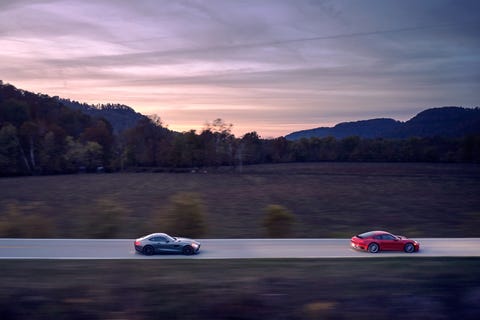
The Mercedes-AMG GT is the model line's base car. It starts at $116,895 and pumps 469 horsepower out of its twin-turbocharged 4.0-liter V-8. But our lavishly optioned test car rang the register at $131,315. It's the company's third go this century at a long-nose, two-seat V-8-powered sports car that puts the driver on the rear axle, after that Las Vegas of supercars, the SLR McLaren, and the gullwing-doored SLS.
2nd Place: Mercedes-AMG GT

Pros: Sultry styling, thundering exhaust note, well-appointed interior.
Cons: Unforgiving ride, poor outward visibility, prone to the occasional twitch.
Verdict: Hits many of the right notes but doesn't really play the song properly.
With the GT, Mercedes plucks the emotional strings like a true virtuoso. Look at it. It's wide and low, carrying its visual weight near the ground. The passenger canopy sits so far rearward that it appears as if speed itself had swept it back there. Its absurdly long hood telegraphs power and perhaps a rude Freudian suggestion. And its tight chopped-roof cockpit makes you feel as though you were deep in the belly of the beast.
The GT's shape and its sound might be rooted in old sports- and racing-car emotional triggers, but damn if they don't still elicit the intended responses.
Listen to it. Of all modern carmakers, Mercedes is perhaps the best at retaining a V-8's deep growl even while slapping turbos between the engine's explosions and the exhaust's throat. Quickly hop off the throttle, particularly in Sport Plus mode, and the resulting pops sound as though they're going to rip the exhaust open at the seams.
It's all comfortably familiar, a compelling rendition of an old song. The GT's shape and its sound might be rooted in old sports- and racing-car emotional triggers, but damn if they don't still elicit the intended responses.
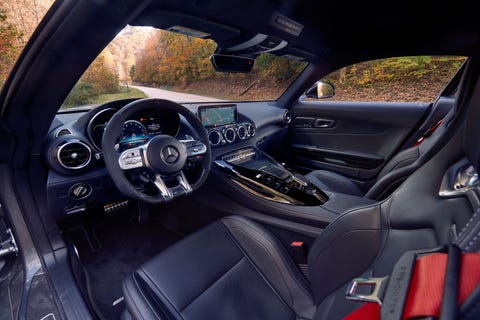
And yet, the GT is outclassed by the 911 in most categories on our score sheet. Its torquey V-8 is more flexible than the Porsche's smaller flat-six. It has far more features and amenities than the lightly equipped Porsche. And even though the interior feels like a cocoon that passengers will soon want to break out of, the Mercedes scores a victory in cargo volume. (The Porsche's vestigial back seats prove to be pretty good parcel shelves, but we count that extra space in the features, not cargo, calculation.)
At 3709 pounds, the Mercedes is 330 pounds heavier than the dimensionally similar Porsche. Its heft turns the GT's power advantage into a power-to-weight disadvantage. That, combined with a launch-control program that cannot match the Porsche's, means the Mercedes trails by more than half a second to 60 mph and through the quarter-mile. Hitting those marks in 3.5 and 11.8 seconds, respectively, the GT is still a very quick car. But you know, the big fish eat the little ones; it's the nature of the world.

2020 Mercedes-AMG GT R Roadster
A similar fate met the Mercedes on the skidpad, where even with a stellar 1.06-g performance, it couldn't quite match the Porsche. The GT also chewed up the corners of its front Michelin Pilot Super Sport tires. The 911's front Pirelli P Zero PZ4s looked almost showroom new after its skidpad runs. Plus, the GT stopped from 70 mph in 156 feet, 15 longer than the 911 managed.
But the performance numbers are close enough that if the Mercedes were the more enjoyable car to drive, we could forgive these shortcomings. But it's not. Its ride quality is pretty unforgiving. Its steering is direct, but effort doesn't build naturally as cornering forces increase. And the GT's seven-speed dual-clutch auto is not as quick to downshift as the 911's transmission.
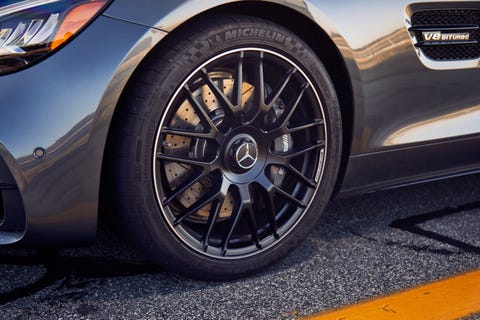
1st Place: Porsche 911 Carrera S

Pros: Supercar quick, GT-car accommodating, world's best automatic transmission.
Cons: When you forget that the fuel filler is on the front fender.
Verdict: Better at straddling than a bowlegged bull rider.
Seems odd to think of any 911, even this newest generation, as the more modern vehicle in a pairing. Porsche has been slowly developing and tweaking the same basic concept for longer than most of our staff has been alive. And yet it is the vehicle that makes fewer of the sacrifices performance cars have traditionally made.
The Porsche's fittings are, in fact, beautiful in their own way. Layers of black with slightly different textures and reflectivity make you feel as though you were sitting in a modern wristwatch.
Casting roughly the same-size shadow as the Mercedes, the Porsche manages to carve out a surprisingly spacious interior. Though small and upright, the rear seats suffice to take young kids on an ice-cream run or they can hold easily accessible cargo. Outward visibility is Honda Accord–like compared with the Mercedes's. A relatively low center console and a dash that does not wrap around into the door panels give the 911 an almost airy feel. And even our six-foot-five co-driver was not cramped.

2020 Porsche 911 Finally Available with a Manual
He was, however, less enthused about the 911's interior than was your narrator. He noted that there's no good place for a driver to set a mobile phone. About this, he is correct. Further, he noted that the lightly optioned Carrera S's all-black, near-minimalist interior seemed a bit cheap for a $100,000-plus vehicle. He preferred the GT's more traditionally luxurious interior. About this, he is misguided.
The Porsche's fittings are, in fact, beautiful in their own way. Layers of black with slightly different textures and reflectivity make you feel as though you were sitting in a modern wristwatch—one from Porsche Design, for example. Check out the fingertip-pleasing knurling on the ends of the toggle-switch-like controls. Feel how precise and hefty their movements are. I might opt to replace the muddy-sounding standard audio system with either the $1600 Bose or $5560 Burmester upgrade. Otherwise, this guy's happy.

Not only does the Porsche have a more livable interior, it has a smoother ride than the Mercedes (assuming you use the recommended "comfort" tire pressures for light-load sub-165-mph driving). It also makes a clean sweep of the performance tests, delivers better fuel economy, and costs less. Is there anything wrong with this car? Not really.
In addition to being practical, the 911 is one helluva back-road companion. Set it to Sport Plus mode and the dual-clutch transmission fires off ridiculously quick shifts that manage to somehow never upset the car. And the automatic is absolutely telepathic. You can work the paddles, but honestly, the transmission is just as adept at picking the time and place for gearchanges. It's that good. The Porsche's handling is utterly confident with none of the surprises of the Mercedes. The 911 is a clean high; no side effects.
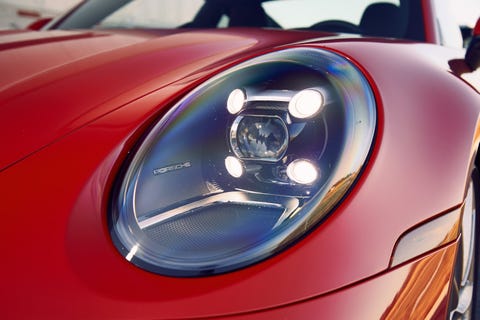
And clearly the 911 is a car developed for the real world. Even in its stiffest setting, it just eats up midcorner bumps and never gets thrown off course even on the haphazardly maintained or repaired Kentucky roads that comprised our driving loop. Okay, the Porsche doesn't have the rolling-thunder exhaust of the AMG, but the rip of a flat-six is a sublime substitute.
From the start, the 911 was designed to be an everyday, all-weather sports car, a sensible toy. This new version, with a shocking breadth of talent, proves that the formula works better than ever.
